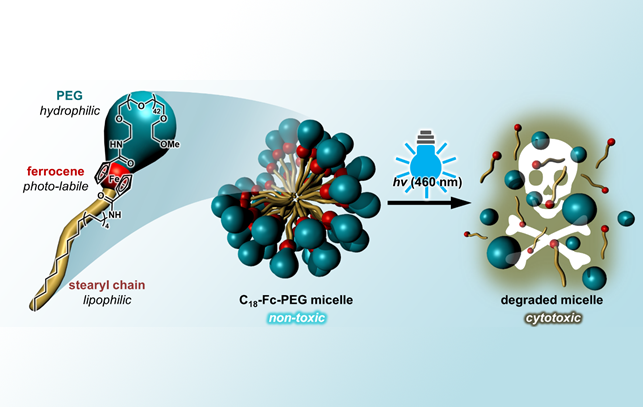One of the challenges of nanomedicine is to deliver active molecules across different biological barriers to reach a specific target, thereby limiting the adverse effects caused by poor drug delivery to healthy tissues. With the advent of nanotechnologies, many drug vectors are now available, but few of them allow for 'on-demand' drug release with control over both space and time.
SELF-ASSEMBLY OF AMPHIPHILIC FERROCENE DERIVATIVES
The SCBM Nanosciences team (MTS department) has set itself the goal of developing such objects. In collaboration with the Institute of Macromolecular Chemistry (Prague, Czech Republic), the researchers have developed photoactivatable nanometric micelles obtained by self-assembly of amphiphilic molecules derived from ferrocene. Ferrocene is a 'sandwich' molecule: its metallic iron centre is sandwiched between two aromatic rings. Ferrocene has a triple advantage in this design:
- it is the central link between the hydrophobic and hydrophilic parts of the amphiphile;
- it can be photodegraded;
- the photodegradation releases a "Fe3+" entity which induces oxidative stress in the cell. This stress produces a powerful cytotoxic effect that could be used to destroy tumours.
In the absence of light illumination, the micelles are perfectly tolerated in vitro and rapidly internalised into cells without any cytotoxic effect. However, 460 nm illumination of cells in contact with the micelles results in the following sequential events: i) activation of ferrocene, ii) dissociation of the micelles, and iii) release of cytotoxic iron species.
FROM BLUE LIGHT TO INFRARED?
Due to its low tissue penetration, the blue light used is currently only suitable for topical treatment of conditions such as skin cancer or psoriasis. A version that can be activated in the near infrared is currently being developed by the nanoscience team to reach and treat tumours deeper in the body.

© CEA / E. Doris / E. Gravel
Contact within the Frédéric-Joliot Institute for Life sciences: